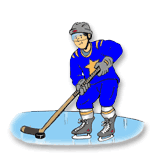 Ice hockey is classified as a “collision sport” by the American Academy of Pediatrics. It is a popular winter sport, but injuries are common and can be quite severe.
Ice hockey is classified as a “collision sport” by the American Academy of Pediatrics. It is a popular winter sport, but injuries are common and can be quite severe.
- According to the Centers for Disease Control, ice hockey is the second leading cause of winter sports injury among children, and most injuries are a result of body checking.
- Sprains, bruises, fractures, facial cuts and head injuries – including concussions – are the most common types of ice hockey-related injuries.
- The severity and number of ice hockey-related injuries are reduced through the use of safety gear and changes in the rules of how the game is played among children.
Safety Tips
Equipment
Make sure your child wears safety gear at all times when playing or practicing. Equipment should fit properly and allow freedom of movement.
- Check safety gear and equipment regularly for wear and tear, and to ensure it is in good condition.
- Purchase a foam-lined helmet specially designed for ice hockey. Never buy a used helmet. Replace a helmet if it has sustained significant blows.
- The helmet should fit snugly. Check the chinstrap snaps frequently.
- A full face mask can protect your child’s face and eyes. Plastic visors should be checked for scratches or cracks. Wire face protectors should be solid, with no broken wires.
- Insist your child use a mouth guard. They can be specially molded for your child.
- Shoulder, chest, elbow, leg, knee and shin pads, as well as padded gloves, should be worn. Groin protection is advised.
- Ice skates should fit your child and provide ankle protection. Ice skates that are too large – or too small – can be dangerous.
- Remember the “chin rule ” when buying a hockey stick. With ice skates on and the stick resting on the end of its blade, the butt of the stick should come to three inches below your child’s chin.
- Goalies need special protective gear to stop high-speed slap shots. Make sure the gear your child wears is correct for his or her position on the team.
Playing the Game Correctly
- Teach your child good sportsmanship. It has been shown to reduce injury and penalty rates.
- Children should warm up before playing.
- Before the start of a game or practice session, check the ice, goal net and arena for damage or hazards.
- It is important that your child learn and practice how to fall properly.
- Teach your child: “Heads up! Don’t Duck!” Players who duck their heads in collisions are more likely to sustain spinal cord injuries. Players should learn to protect themselves by making board contact with anything other than their heads.
- Heads Up Hockey
- The American Academy of Pediatrics recommends body checking should not be allowed for children age 15 or younger.
- Children should not play through pain. Seek medical evaluation for any injuries.
- Encourage children to take plenty of rest breaks and to stop when they get tired.









 Ice hockey is classified as a “collision sport” by the American Academy of Pediatrics. It is a popular winter sport, but injuries are common and can be quite severe.
Ice hockey is classified as a “collision sport” by the American Academy of Pediatrics. It is a popular winter sport, but injuries are common and can be quite severe.